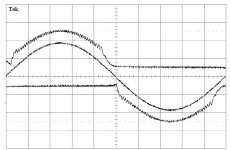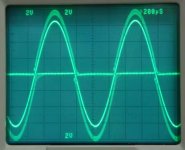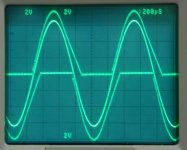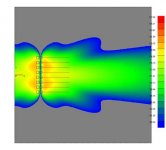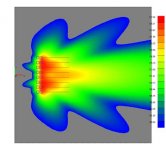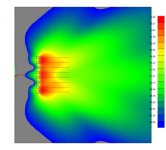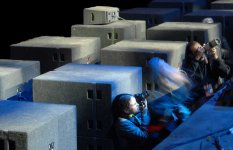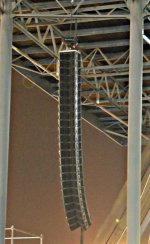Workhorse said:Toino, the waveform you have posted doesn't tally with the Lab amp FP+10000Q.....or is it from some another amp or model.....
It looks like a UCD-like self oscillating system as opposed to the clocked approach. I think that someone pointed out that the newer models were self oscillating rather than clocked.
BTW could anybody show oscilloscope captures of the clocked version?
Eva said:
It looks like a UCD-like self oscillating system as opposed to the clocked approach. I think that someone pointed out that the newer models were self oscillating rather than clocked.
BTW could anybody show oscilloscope captures of the clocked version?
Evita, Lab FP+10000Q series utilize forced clock 614KHz generated from CD4060 + 12MHz crystal.....
Have a look at this much cleaner waveform.....😉
Attachments
Uhm, looks nice, but notice the delay at zero crossing (increased crossover distortion??). In my opinion the self oscillating approach seems to mimic better the audio waveform.
Damn, everybody seems to be reverse engineering those amplifieres!!!! I want one too!! 😀😀😀
Damn, everybody seems to be reverse engineering those amplifieres!!!! I want one too!! 😀😀😀
Which LabGruppen uses the selfoscilating supply modulator, the older one or the newer one? Anyone has schematic of the selfoscilating LabGruppen TD? (email : lumanauw@bdg.centrin.net.id)
Go to the class D forum and search for UCD. This is the self oscillating modulator, it's just a comparator with lead and lag networks at its inputs driving a power stage, stupid but very effective (and patented, I think).
Well, if you say it is good, probably it is...
Here you have a sequence of pictures.
This thing works with high bias to force tracking.
The sequence shows the effect o bias adjust variation.
Here you have a sequence of pictures.
This thing works with high bias to force tracking.
The sequence shows the effect o bias adjust variation.
Netlist said:/Mod hat on
Please cooperate instead of obstructing each other.
/Mod hat off
I’m sure this can be made a most interesting thread about pro gear, something sparsely found on this forums.
/Hugo
Following this suggestion and a little of-topic, this is my last successful work with big concert.
The problem to be solved is related to the omni-directional dispersion characteristic of big infra-bass boxes.
Mounting it in two separated groups, as usual, produces irregular dispersion due to destructive interference.
Good solution is mounting it in front of stage. Only one sound origin doesn’t produce destructive interference.(I am simplifying for better understanding. They are always interference and this work is heavily based on them)
However they are two big complications with that solution:
The horizontal size of array (bigger than 1 wavelength) is very directive. (picture 1)
The other problem is that we have almost the same pressure sound on stage (picture 1)
As a solution for the second problem, I have developed a signal processing algorithm and installed it on a Soundweb Dsp.
The Dsp and the loudspeaker positions practically silent the stage in the full loudspeaker bandwidth (about 2 octaves) as seen on picture 2. Note that they are 2 loudspeaker groups, one in front of other. This arrangement and the signal processing produce a kind of very effective cardiod like dispersion for more than 2 octaves.
The remaining problem of directivity is solved with introduction of delays in a way to simulate an arc with centre on stage.
(picture 3)
The physical arc montage was impractical due to space restrictions.
Total loudspeaker boxes is 48 band-pass 102dB 1W/1m-1.5KW (28-70Hz)
The result: simply amazing!
 and uniform pressure everywhere!
and uniform pressure everywhere!However on stage, some bass guitar performers, have asked if the PA was not connected…😀
Attachments
Eva said:Uhm, looks nice, but notice the delay at zero crossing (increased crossover distortion??). In my opinion the self oscillating approach seems to mimic better the audio waveform.
Damn, everybody seems to be reverse engineering those amplifieres!!!! I want one too!! 😀😀😀
Evita, the bias of this amplifier is very low only 10mA per device thats why there is an increase in cross-over distortion...
Currently Lab Gruppen is supplying these amps as OEM to
Martin Audio & L.A. Acoustics
and the www.alab-pro.com copies it very well.....
Certainly no reverse engineering from my side because Class-TD still has somewhat less efficiency,increased complexity,higher cost than Class-D thats why its not worth implementing.....😉
Just to finalize this is a view from backstage.
Photographers previously and seriously warned to do not pass in front of loudspeakers.
They are perfectly safe there. I through that they automatically found the best position.
Two steps back is a real molecular agitation inferno. 😀 😀
😀 😀
Photographers previously and seriously warned to do not pass in front of loudspeakers.
They are perfectly safe there. I through that they automatically found the best position.

Two steps back is a real molecular agitation inferno.
 😀 😀
😀 😀Attachments
Sorry but it is not complete without this one.
This is the left side Line-Source array for 100m length coverture.
Only 800Kg. But don’t be fooled by the small size. It is full-range with 4x8” loudspeakers and two 1.5” drivers in isophasic waveguide.
These things must be of small height size for optimal vertical coupling at low-mid frequencies.
The individual rig system is adjusted in 0.25 degree linear steps for precise positioning.
1 degree step, as used on most of this kind of boxes, has not enough precision. It means several meters at a target distance of 50m, for example.
4x8” loudspeaker has roughly the same surface of a 15” loudspeaker. Each box is 1.2KW 102dB-1W/1m at low-mid.
It is amazing how far they could project sound, with good whether…!
And without killing everybody near the front stage.
I remember one of last “old cellular” (4 years old) sound systems in the some place; 6 Ton.!!! Each side… 😀
This is the left side Line-Source array for 100m length coverture.
Only 800Kg. But don’t be fooled by the small size. It is full-range with 4x8” loudspeakers and two 1.5” drivers in isophasic waveguide.
These things must be of small height size for optimal vertical coupling at low-mid frequencies.
The individual rig system is adjusted in 0.25 degree linear steps for precise positioning.
1 degree step, as used on most of this kind of boxes, has not enough precision. It means several meters at a target distance of 50m, for example.
4x8” loudspeaker has roughly the same surface of a 15” loudspeaker. Each box is 1.2KW 102dB-1W/1m at low-mid.
It is amazing how far they could project sound, with good whether…!
And without killing everybody near the front stage.
I remember one of last “old cellular” (4 years old) sound systems in the some place; 6 Ton.!!! Each side… 😀
Attachments
Yes indeed.
But with all modern “Power multiplication miracle” of pseudo practical engineering, I still use good old 30Kg amplifiers for sub-bass.
The truth is that I have tried several lightest ones, and with 1 exception, all failed miserably in one aspect or another when directly compared with the older reference.
The exception could not be used because the signal is processed internally by Dsp and the resulting latency is not compatible with my actual algorithm.
But with all modern “Power multiplication miracle” of pseudo practical engineering, I still use good old 30Kg amplifiers for sub-bass.
The truth is that I have tried several lightest ones, and with 1 exception, all failed miserably in one aspect or another when directly compared with the older reference.
The exception could not be used because the signal is processed internally by Dsp and the resulting latency is not compatible with my actual algorithm.
TOINO said:Yes indeed.
But with all modern “Power multiplication miracle” of pseudo practical engineering, I still use good old 30Kg amplifiers for sub-bass.
The truth is that I have tried several lightest ones, and with 1 exception, all failed miserably in one aspect or another when directly compared with the older reference.
The exception could not be used because the signal is processed internally by Dsp and the resulting latency is not compatible with my actual algorithm.
Toino, would you please describe precisely what was "Lacking" in the "Lighter Amps" when compared to your "30Kg Reference Amp"...
Simply stating that lighter amps are not good for Sub-Bass than heavier ones is plain non-sense....provided all amps under comparision must have same power ratings......
Kanwar
- Status
- Not open for further replies.
- Home
- Amplifiers
- Solid State
- LabGruppen, what to do?
